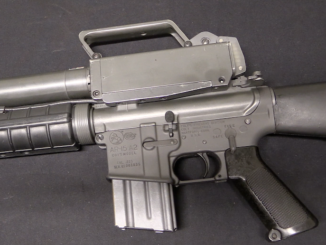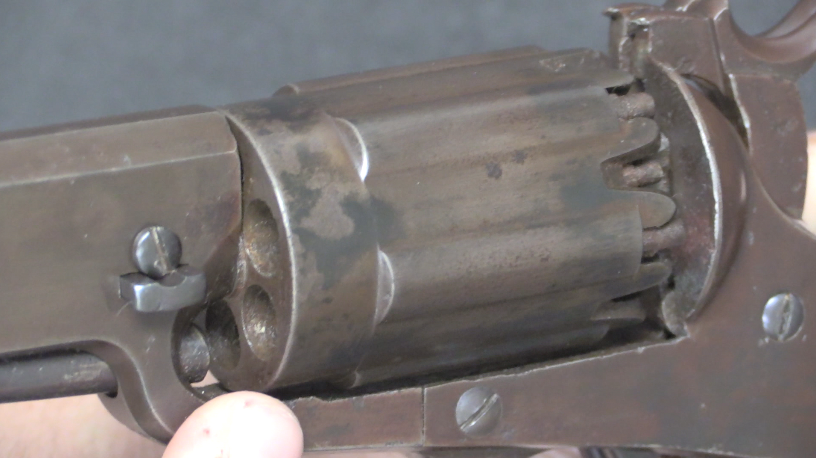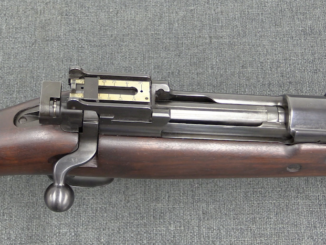The Calico family of firearms was developed in the late 1980s, and put on the market just in time to be squashed by the 1994 Omnibus Crime Act. The heart of the Calico system was a design for a double-stack helical magazine, which was made in 50- and 100-round versions in both ,22 rimfire and 9mm Parabellum. Both pistols and rifles were made in both calibers, and I am looking at the 9mm type today. Where the ,22s were simple blowback, the 9mm Calicos used the roller delayed blowbacks system developed by H&K. The company was hoping for military or law enforcement, but suffered from a poor reputation for reliability and never got a significant military contract. They also pursued civilian sales, but manufacture of magazines holding more than 10 rounds was prohibited in 1994. Without its large magazine, there was really no reason to choose Calico, and the company basically went into a coma until the ban expired in 2004. It was sold in 2006 and still appears to exist, although I suspect they are simply working from old stocks of guns and parts.
(Disclaimer: both of these Calicos were purchased by me on the secondary market; the Calico company has no connection to this video)




enjoyed it as a range toy never even show it to a serious shootist
A Californian on the late Weaponeer.net was working on an AR upper using these mags – when the grandfathered mag ban hit he moved his workshop to AZ.
Spaceballs
Calico series seems to be liked as movie props http://www.imfdb.org/wiki/Calico_Series_of_Rifles_and_Pistols
Questionable mag and bulky, garish plastic aside, I love the elegant compactness of the bolt group (other end of the spectrum from the tall and complex HK setup requiring a complex receiver as well). I’d love to see a manufacturer follow this to its logical conclusion with a receiver / form factor of comparable simplicity.
I’ve been wondering when Ian would get around coveringq these!
Some really cool weapons from a company that wasn’t afraid of trying something new and original instead of making yet another 1911/AR15 clone.
Crazy that they start at around 1000$ today.
A couple of Calico’s bought back in the day would have been a surprisingly good investment!
I called them up a couple of years ago just to see if they still existed. The person who answered the phone sounded rather distracted, but shortly said Yes! I had hopes for them back in the day. For mechanical reasons related to the proportionate length of the cartridges ( I never fully understood as I am mathematically challenged) they were never able to successfully adapt to other chambering, so just .22 and 9mm would work well with the magazine design.
A friend of mine was the owner of a Calico carbine long ago (w/collapsible stock, if memory serves, and two magazines, of 50 and 100 rounds). I remember him saying the gun was fun to shoot but plagued by reliability issues. He was and is a competent shooter who knows how to properly clean and maintain his guns. Also remember something about the helical mag main spring requiring (very) careful handling and a specific procedure for winding: you had to be very precise in the number of times you wound it up. Otherwise, feed issues would be more or less inevitable.
Helical mags, like drum mags, seem to be headaches no matter what. That big spring appears to be the source of the trouble. Perhaps a weapon-powered rather than a spring-powered system would work better — if (big if) sufficient force could be obtained from, say, the motion of the bolt/carrier.
The above is an example of my favorite hobby: thinking up work for other people to do.
Right. I’d say helical mags are even finicker than drum mags.
I also just remembered another, albeit minor, complaint from my friend regarding the Calico he owned back in the 90s: the plastic used on his specific gun wasn’t great either. He sold it without too many regrets a few years afterwards.
A similar issue occurs with the pan magazine. The Lewis Gun had a pan that was indexed by the bolt. In contrast, the Vickers K had a pan magazine with an internally sprung follower. Both had problems with lateral space. But that aside, helical magazines are more difficult to craft than pan magazines. I could be wrong.
Nitinol; heat could do stuff and make said thing happen.
Crack on, good luck.
@Ed @R. Aballe
Helical magazines are an engineering issue for sure, but so were regular and double stack SMG magazines back in the day.
The advantage they offer in terms of rounds carried and space vs drum mags (and some regular mags) is significant.
They seem to have become more popular the last decade or two. The Russian use them in the Bison, the Chinese use them in their Chong Feng (?) SMG. And North Korea uses a helical magazine in their Type 88 assault rifle.
Wonder if they’ve solved some of the issues with helical magazines. Especially the Type 88 seems to be issued quite widely.
My wild guess is no, and these examples are more of a curiosity.
Interesting that not one of these korean mags ended in the west, or at least china, for analysis if they work at all.
Imagine this thing with a side mounted straight magazine, proper sights and a better stock. It would be a fine SMG.
@Storm
Well, not having a copy to examine is probably what is to be expected from a country as paranoid and closed as North Korea.
(Notice how pretty much the only North Korean guns available are Korean War bringbacks.)
The North Koreans are incredibly paranoid about gun control (as any totalitarian society, I suppose.) Never mind guns, even just a missing bullet is treated as very serious business.
I remember reading a defector telling about his service in the army: Right before they were off on break, some NK grunt managed to lose a bullet. And presto: Break is cancelled and the entire battalion called is called into action to find the missing bullet.
As for whether they work at all, I don’t think there can be any doubt. The troops we have seen equipped with these magazines are all elite units. (soldiers guarding the big guy or the DMZ.)
In other words: Not troops you’d equip with a “sorta works” magazine.
I had one in 1990-92. Pretty ergonomic for the time and the in-line recoil with the downward eject was slick. Disassembly and cleaning of the mags and the carbine was a snap. The tension never was a problem either as I never wound all the mags unless I was going to shoot it. I would keep one wound and change it out every week to keep the spring fresh although this may not have mattered that much. All four of my mags fed great and it was accurate as can be out to about 200m with the scope mount and a cheap red dot site (Tasco?). I used various FMJ’s, mostly Fiocchi 115 or 123? grain, I never tried JHP’s. The problem was the firing pin tooth that engaged the sear broke, twice, leading to unwanted (and embarrassing) full-auto. The customer service was fantastic though and after it broke the second time they just sent me a new carbine (promptly sold to a buddy more interested in the “shady machine-gun” idea than I was). My impression was the metallurgy on that part was bad on some of them. It ran great full-auto too but the only way I got it to cut off both times was pull the mag. It seemed to be running at least 750 rpm, and may have been higher. Sort of a freaky experience but probably a fluke as I never heard of anyone else having that issue with a Calico.
@Scotty
So… What I hear you saying is, that it’s easy to turn into a machinegun?
Damn, that Calico really has everything going for it, eh?
Lol
(Granted, the “wont stop firing until out of ammo” part did sound a bit inconvenient.
Thanks for sharing your impressions on the gun.
What is this firing pin tooth, if that is correct name, can you show it on some parts diagram ?
A mistype. Firing pin tooth is a really bad (wrong) label as you pointed out. It was the piece of the bolt that would catch on the sear. It just kept breaking off.
I would like to see the Calico compared to the Soviet PP-19 Bizon.
I remember those guns form sci-fi movies, they looked ultra futuristic and so in movies like ”Total Recall” they were used by the Martian Security Forces, lots of fun.
To be honest, I miss the 80s-90s movies with various exotic firearms of that development era, most of them were not sucessful but had futuristic looks and some innovation, just like Calico, or Striker shotgun, Goncz, etc.
Nowadays 99% of hollywood movies feature AR-15s with shitty rails and other tacticool addons, Its unbelievably boring.
The prop makers use what is cheap and easily avaiable. Throwing the Tapco catalgue at a gun is probably the easiest way to make a movie gun.
I remember when these came out, I was in Jr. High, and every kid wanted one. Sadly never saw one in real life except at gun shows, and almost always beyond my price range. Looking forward to seeing you shoot them!!
Interesting story.
Perhaps this is just the case when the designer takes on the job, undoubtedly competent and gifted, but acting in isolation from reality.
The first problem is a poor understanding of the internal dynamics of the bolt assembly. The lack of unambiguous synchronization between assembly parts inevitably leads to a spread in the velocities of these elements. Hence, spontaneous malfunctions, and in especially “successful” cases, breakdowns, as Scotty said.
The second is the lack of understanding of the service of such weapons, how exactly this should be used.
The “ingenious” construction of the mag is the root of the problem.
And the design of the gun itself (as already mentioned) does not allow the use of “normal” mags.
As a result, nowhere except for movies is this noticed.
Who remembers the pistol in the movie “I Come in Peace.” wish all calico pistols were that powerful. Haha. Always wanted one just to add to the weird collection. That was a silly but cool b movie.
I never knew these were roller-delayed!
SHit, now I need to buy one…
Doc Dabbs had a review of one of the Liberty carbines in Firearms News a while back. He made it sound good.
The biggest problem with the Calico’s reliability is that although the 9mm Luger cartridge will fit and fire, it isn’t the spec cartridge for it. Calico designed these to run the 9MM NATO cartridge, which runs at +P pressures for Luger rounds. So, if you load it up with yellow-box 9mm, it will occasionally misfire. I have run full 50 and 100-round mags on 9mm NATO through a Liberty III without a single problem.
Dealing with the new calico company is impossible. They never answer their phone or emails. Have been trying to get back a rifle I sent in for repairs for almost two years ago. Was originally told by their engineer that it would be covered for free then said it would be $600. Took them a years worth of calls to finally get the repair tech to tell me he couldn’t fix it something he knew within two minutes of looking at but couldn’t be bothered to contact me. Now all I want is the rifle back and to know how much to send for shipping.
They still do not answer the phone nor return calls in 10/2023.